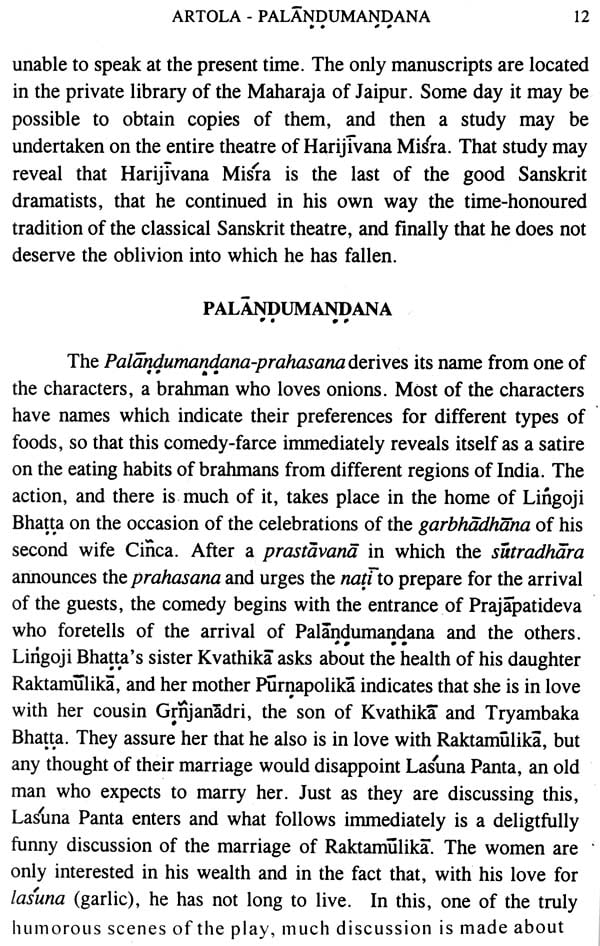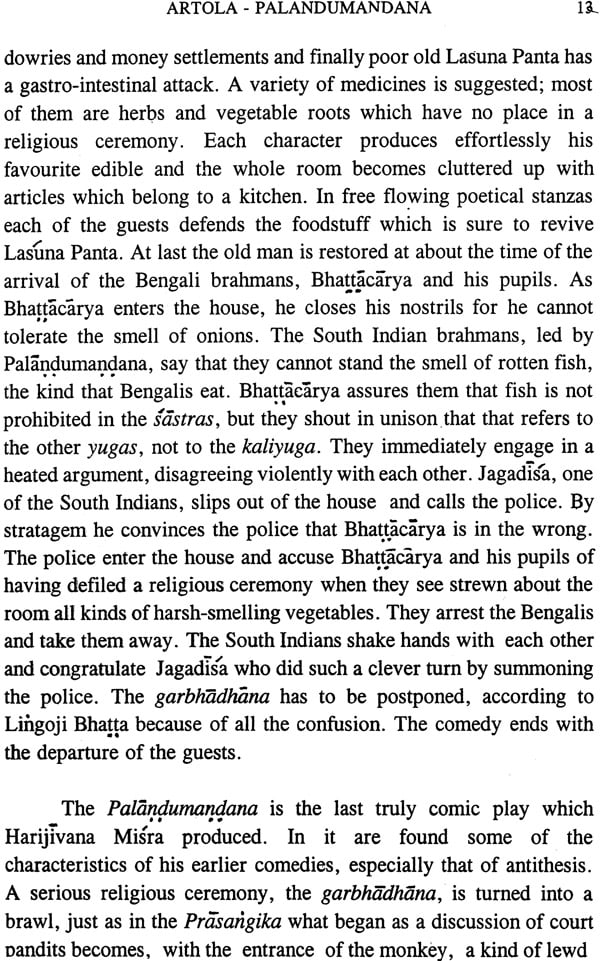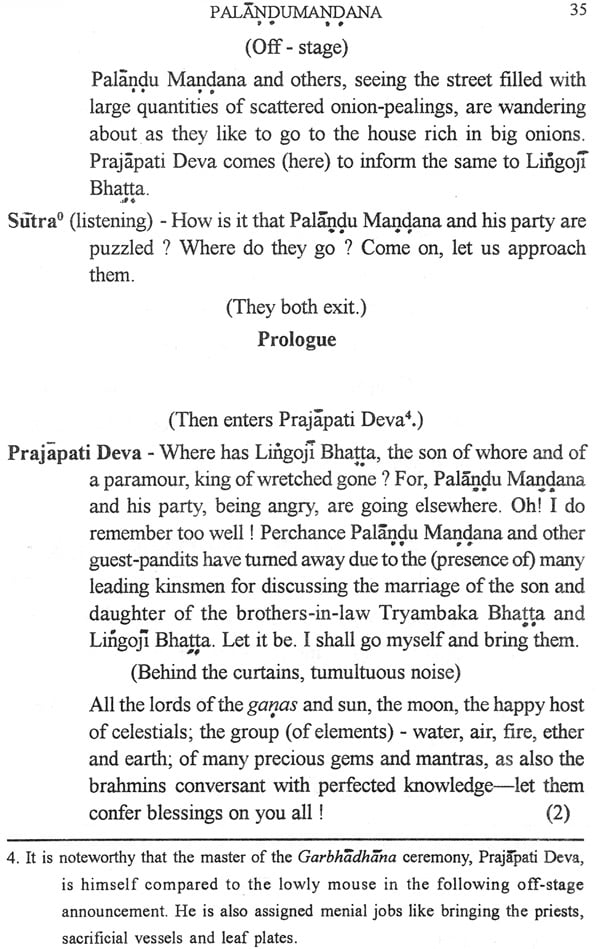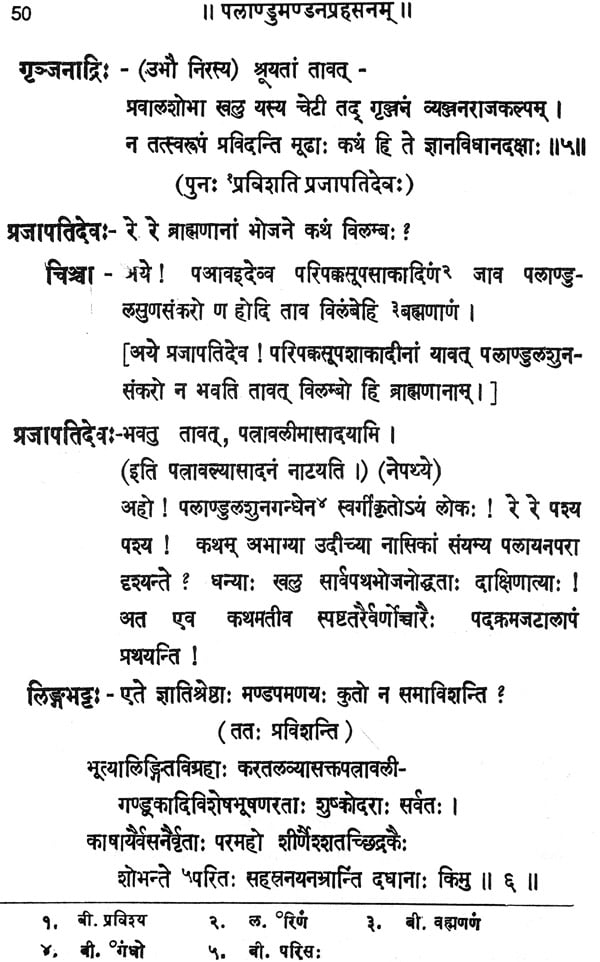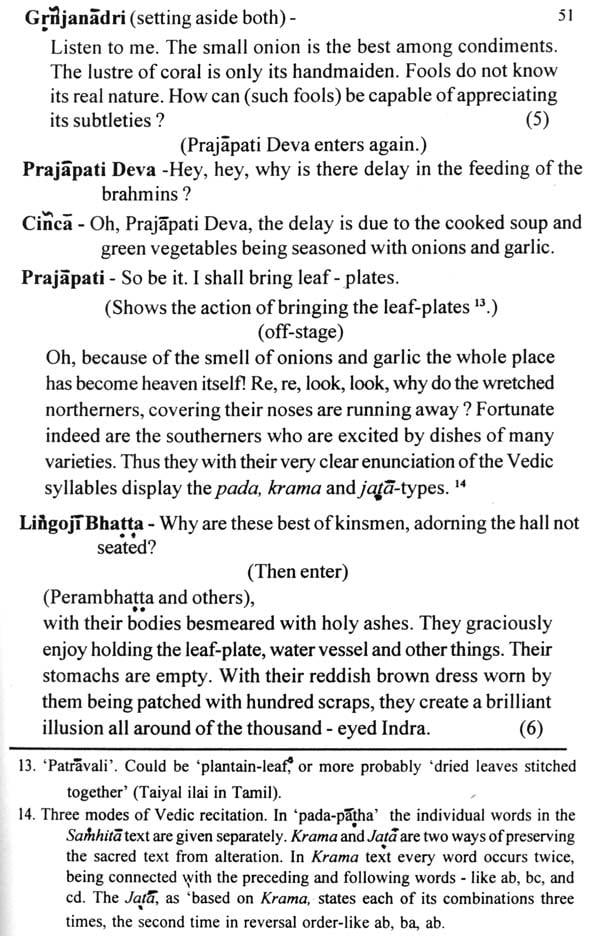
Palandumandana Prahasana or Harijivana Misra (An Old and Rare Book)
Book Specification
| Item Code: | NAP107 |
| Author: | Dr. V. RAGHAVAN |
| Publisher: | THE KUPPUSWAMI SASTRI RESEARCH INSTITUTE |
| Language: | Sanskrit Text With English Translation |
| Edition: | 1996 |
| ISBN: | 818517010X |
| Pages: | 69 |
| Cover: | Paperback |
| Other Details | 8.5 inch X 5.5 inch |
| Weight | 120 gm |
Book Description
Preface
The Governing Body of the Kuppuswami Sastri Research Institute is privileged to bring out, to mark the Valedictory function of its Golden Jubilee on 10th July 1996, a monograph of an edition with critical study and English translation of a little known unique farce, the Palandumandana (P.M.) of Harijivana Misra, a poet scholar who lived in Jaipur in the 17th century.
The Prahasana (comedy – farce) and Bhana (one-man show) are two minor play-forms described by Bharata in his Natyasastra under the general category of described by Bhjarata in his Natyasastra under the general category of ‘Dasarupaka’ . All the post-Bharata dramaturgists also dealth with them. Although distinct in their technical format, the Prahasna and Bhana are rightly clubbed together by Bharata as they are both of pure entertainment value (ranjakapradhana) and form an important medium to expose the weakness of society in general or contemporary to the author. Naturally, clomical and satirical elements and dominant in both of them. It is noteworthy that amongst the ten (or eleven) drama types, besides the full-fledged Nataka, only the Prahasana and Bhana as Preffered by many poet, are represented by a large number fo specimens from the early centuries to the present times.
Until the sixties H.M.’s Prahasanas were not known even to the specialists in ancient theatre as they were all available only in mss. And that too in the Anup Sanskrit Library, Bikaner, not easily accessible, and in the India Office Library, London. In the early sixties, Dr. George Artola, then at the University of Hawaii U.S.A., undertook a project of studying some unpublished Prahasanas which included those of H.M. In this connection he worked at Madras with Prof. V. Raghavan, whose life-long scholarly pre-occupation with the study and practice of classical Sanskrit Theatre is wall known. In May 1965 Artola presented a paper on H.M. and his Prahasanas at the sixth annual meeting of the Samaskrita Ranga, a unique organization founded by Dr. Raghavan in 1958 for putting on boards authentic versions of a range of Sanskrit dramas from the ancient to the present times as available in print and in mss. In this talk Artola highlighted the variety of comic situations created by H.M. in five of his Prahasanas- the adbhutataranga (weaves of marvel) in three acts caricaturing persons in the royal court, most probably of the author’s parton king rama Simha of Jaipur (17th century); the Prasangika rich in humour arising from the use of play on specific words; the Vibudhamohana providing joy for the learned men; the incomplete Ghrtakulyavali on the house-holder Ghrtakulaya- kusala giving chowries to Brahmins instead of the usual daksina; and the P.M. The sixth Prahasana Sahrdayanda is somewhat serious, as it is replete with the technical matters on the Alankara Sastra. Dr. Raghavan’ s paper at the same meeting was on this Prahasana. The above lectures were subsequently printed in the Samkrit Ranga Annual volume IV. 1966.
An edited version of the P.M. as from mss. was also successfully staged on 12th May 1966 at Madras as directed by Dr. Raghavan with the assistance of Dr. C.S. Sundram and myself. A couple of photographs from this presentation as from the Samskrita Ranga photo album are included in the present edition of P.M.
Two of H.M.’s Prahasans, namely the Vibudhamohana and P.M. were published by Dr. Raghavan through the issues ( I. 1966 and III. 1973) of the Bulletein Malayamaruta sponsored by the Rashtriya Sanskrit Samsthan.
Althhough efforts were taken by the two scholars as seen above to bring to light all of H.M.’s Prahasanas, the authorities of the Kuppuswami Sastri Research Insitute though it would be worthwhile to publish P.M. alone with an additional English translation along with its text and the critical information already available. The early issues of the Samskrita Ranga Annuals are not available for purchase. Also the bulletin Malayamaruta has become defunct after bringing out usefully some minor unpublished Sanskrit compositions through its four issues during 1966 to 1978. The Rashtriya Sanskrit Samsthan and its Vidyapeetha family have during the last 2?2 decades, grown in size in many ways. The general students and specialists therefore look forward to the revival of the publication Malayamaruta in the near future.
Contents
| PREFACE -S.S. JANAKI | i |
| CONTENTS | xi |
| CRITICAL INTRODUCTION | |
| HARIJIVANA MISHRA AND HIS SHORT SANSKRIT PLAYS | 1 |
| Adbhutataranga | 4 |
| Prasangika | 7 |
| Palandumandana | 12 |
| Vibudhamohana | 14 |
| THE SAHRDAYANANDA OF HARIJIVANA MISRA | 16 |
| PALANDUMANDANA - Synopsis | 23 |
| DRAMATIS PERSONAE | 28 |
| PALANDUMANDANA-TEXT WITH ENGLISH TRANSLATION | 30 |
